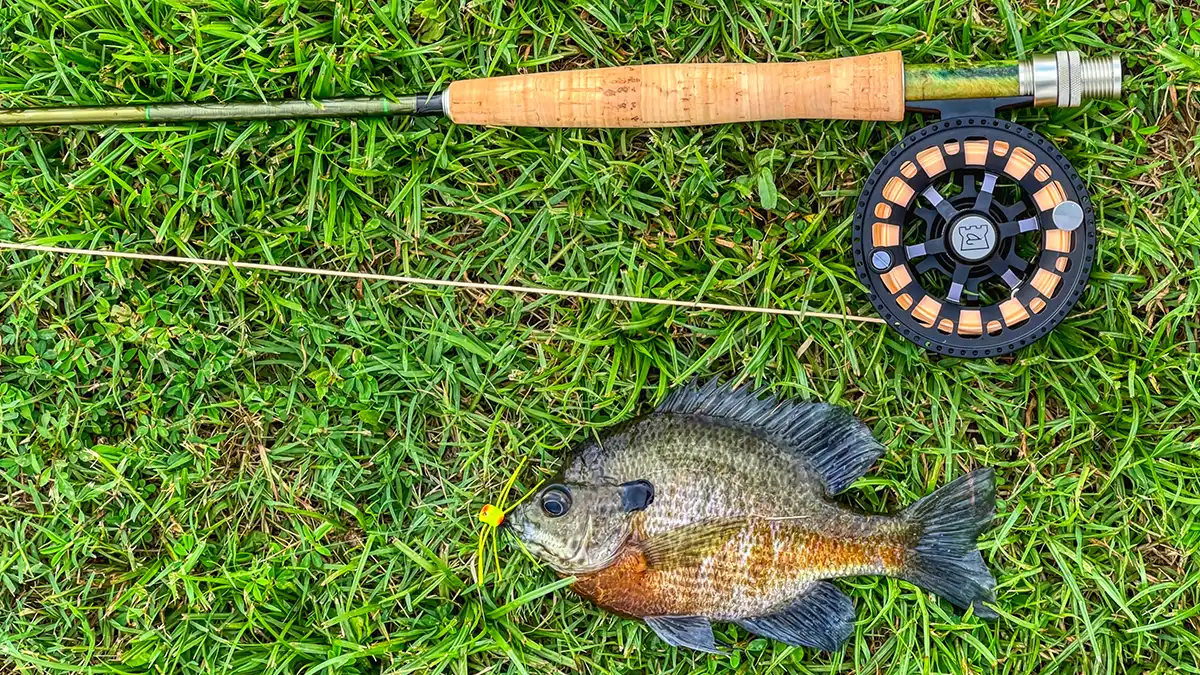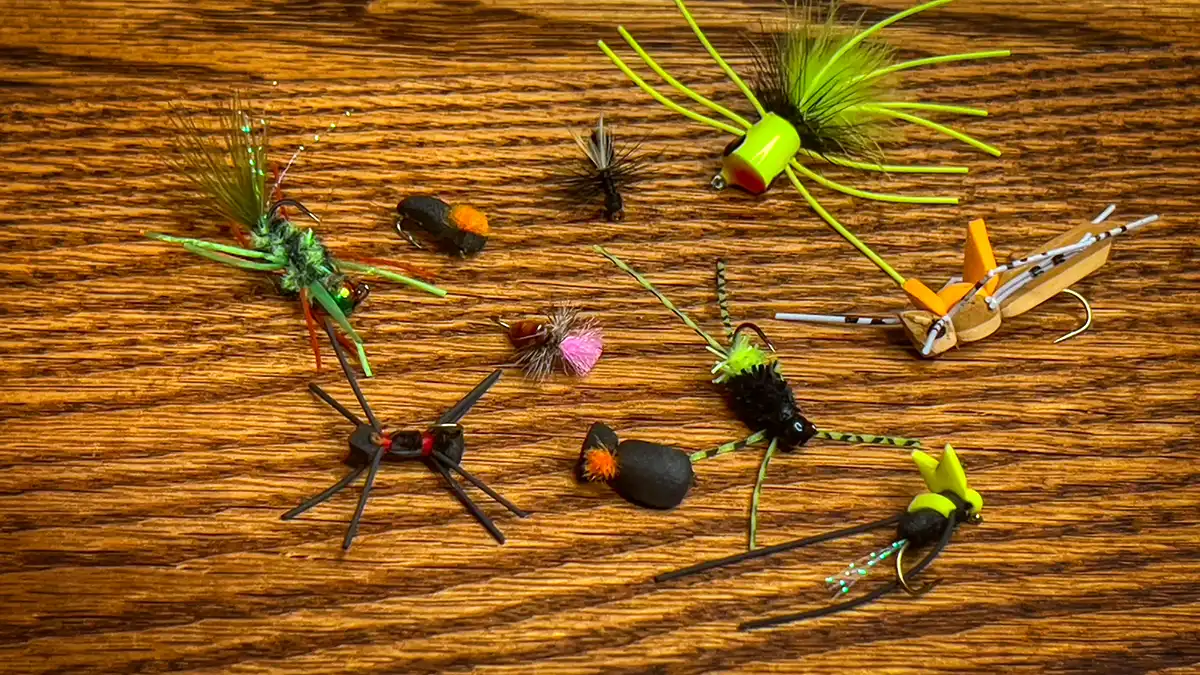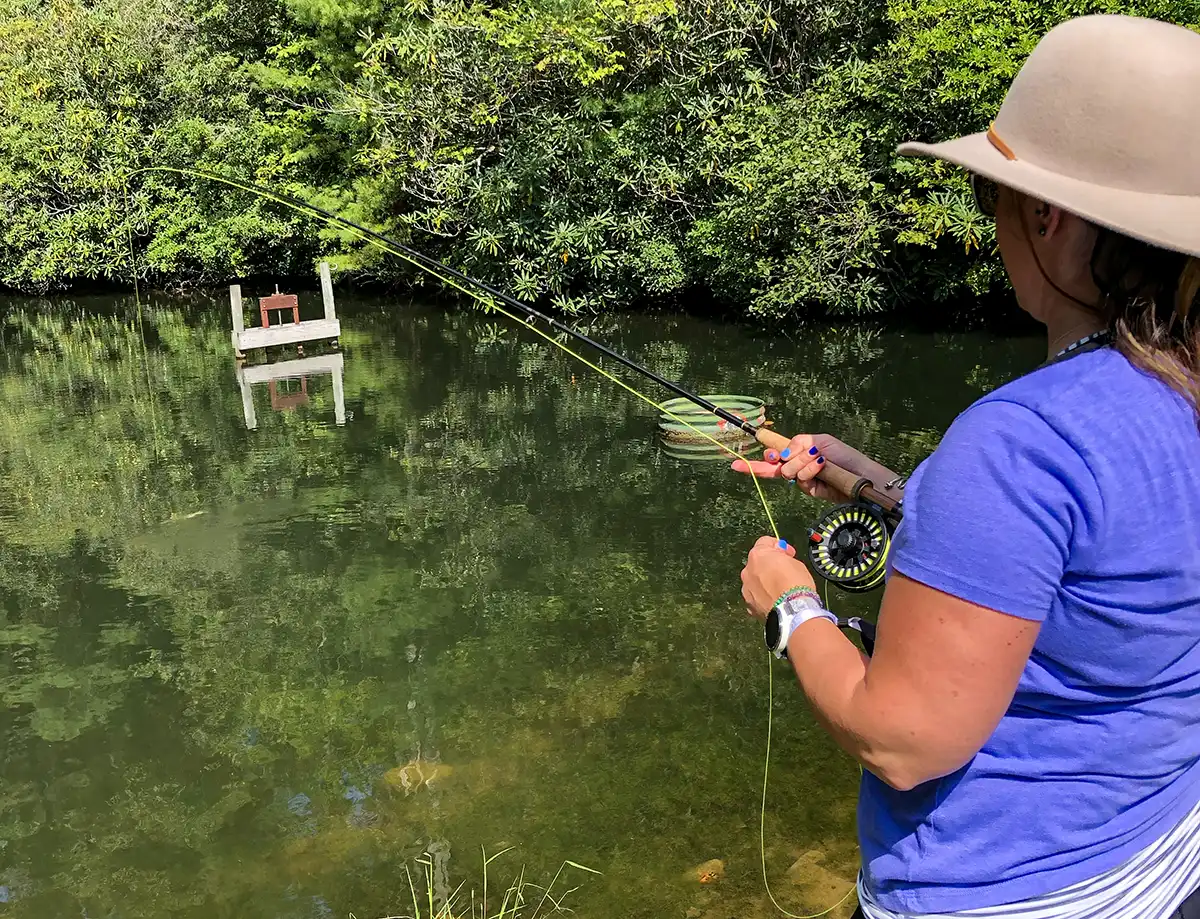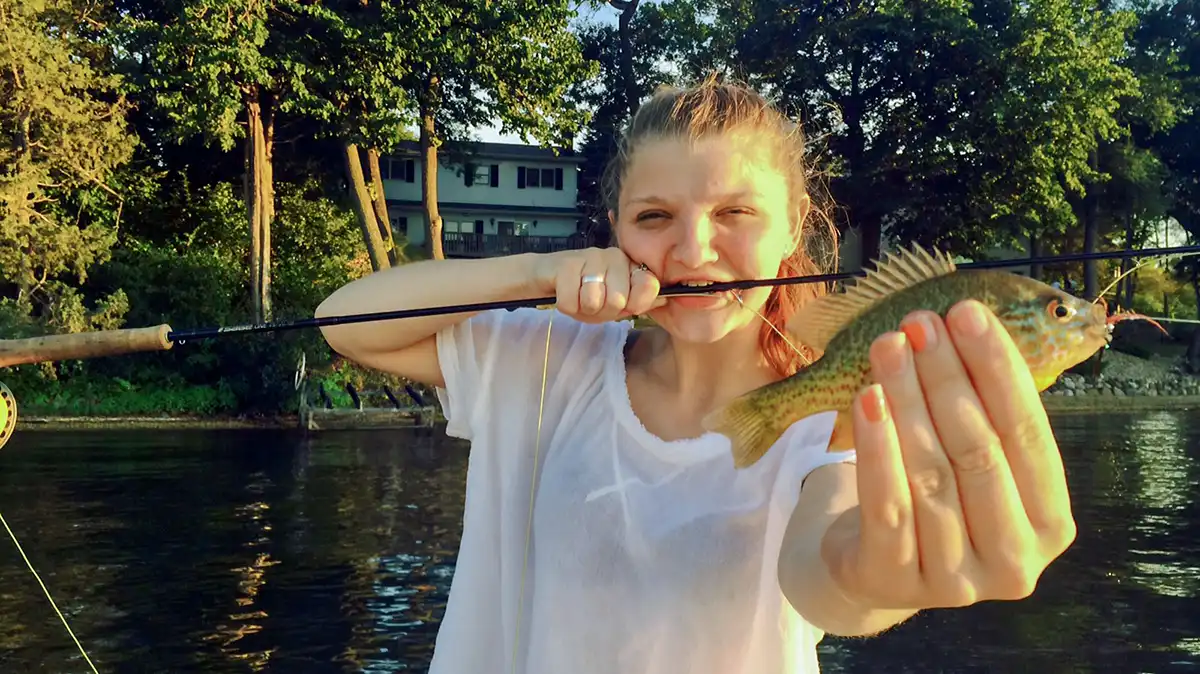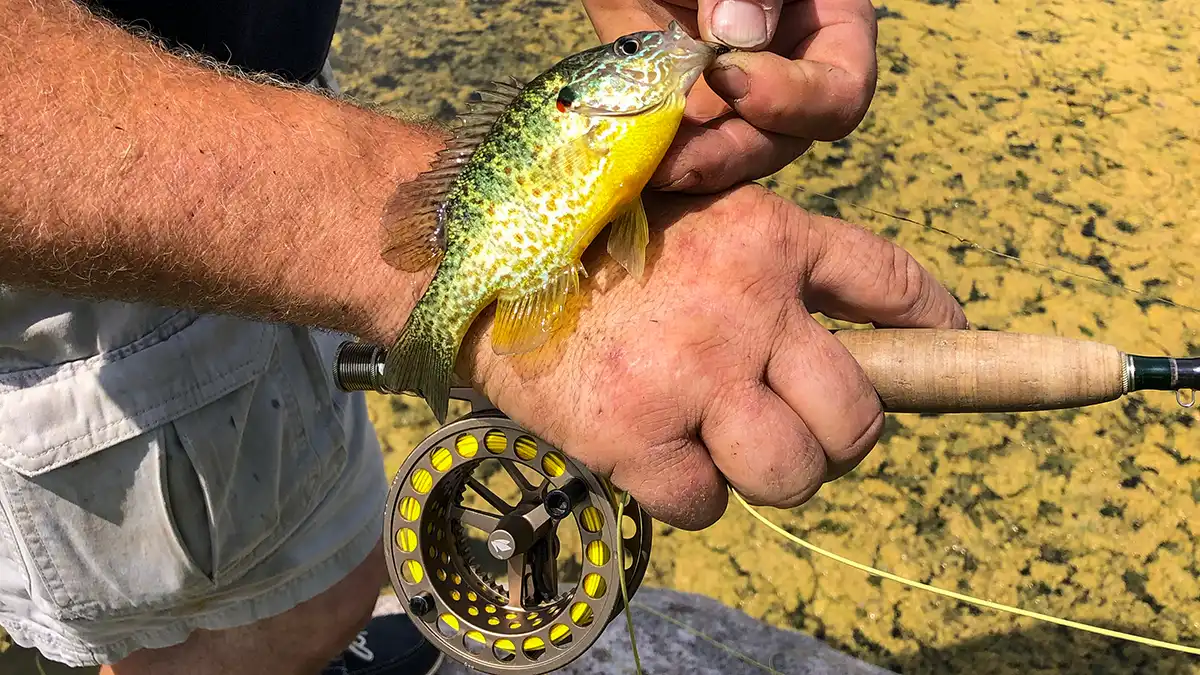You’ve bought the standard 5-weight fly rod and matching fly reel, have a box full of flies from the local shop that you’re not sure what to do with and have been practice casting a fly in your front yard for the past month. It’s time to get your fly fishing gear together and head to the water to try your hand at catching your first fish fly fishing. After all, the reason we do this is to catch fish, and the only way to get proficient at fishing with a fly rod is to practice with the fish. And one of the easiest ways to do this is to go flyfishing for bluegills. It may be the best way to start fly fishing for beginners.
It probably seems that obstacles block your path to your first fish on a fly, and to some newcomers, this might seem a bit formidable. But being successful on your first trip out is as close as the local bluegill pond. So leave the waders at home, pack a snack and some water, and head to the local pond to catch some fish. To be honest, we love taking our fly rods and going after bluegills on a pond. It’s a great way to enjoy a day regardless of your level of competence with a fly rod.
Many new-to-fly-fishing anglers have started their fly fishing journey while on vacation out west by taking a trip down the river with a guide. While I would never discourage someone from having that experience, it is to everyone’s advantage if you have a little practice under your belt before you step foot in a drift boat. The easiest place to get yourself that practice without a lot of the frustration? The local bluegill pond.
Though avid anglers may tend to stick up their noses at Lepomis Macrochirus, I consider the bluegill a fishing lifesaver. Many a fishing trip has been saved by this little creature which normally ranges in size from 6 to 10 inches. The bluegill, which derives its name from the bluish shade on its gill flaps, is found in abundance throughout North America and can be easily caught from shore, and they have a diverse diet that includes insects, which makes them an excellent target for fly anglers. They’re also considered a great fish for beginners to learn on, which is why I’m sure many of us have a photo of our 5 year-old selves shamelessly holding up a poor ole bluegill somewhere.
But just heading to the edge of the local pond isn’t going to automatically make you successful. To make the most out of your first trip, let’s talk about your limitations as a new fly angler and why it’s beneficial when fishing for bluegill.
CHOOSING BLUEGILL FLIES
In the beginning, your cast will need work and your fly will, more times than not, land on the water like a boulder. Take this into consideration when you choose your first fly. The key will be to use a terrestrial pattern. A terrestrial pattern is anything that imitates a bug that lives on dry land; an ant, a cricket, a beetle, a grasshopper. These flies are meant to float on top of the surface of the water so they are easy to see.
Consider what that insect does when the wind knocks it into the water. It spastically bounces around trying to get out of the water as fast as it can. As a new angler, this is great news for you. You haven’t honed your cast to present a delicate fly presentation, and you most likely will not have your line management skills downpat yet (which is the equivalent of patting your head and rubbing your stomach), so you will create chaos with your fly on the water as soon as it lands. It will begin to bounce around just like that insect trying to get the heck out of the water.
Without trying, you’ll create a natural presentation that will imitate a real insect in the water, and before long, you’ll see that little mouth latch on to your fly!
You can get bluegills on dry flies and flies that mimic bugs, spiders, ants, grasshoppers, grubs and more. As well as beaded nymph type flies with legs again that mimic bugs. Here are some recommendations for bluegill flies:
- Betts Bream Getter Flies
- Betts Bream Popper Assortment
- Starky Flies (Gill Getters and More)
- Orvis Bully Bluegill Spider
- Wild Water Foam Beatle
- Wild Water Bumblebee
- Wild Water Mobile Ant
STRIPPING FLIES FOR BLUEGILLS
Once the fly has landed on the water and your line is under control, you’ll want to move the fly in a way that imitates what the fly on the water would do. I call this “being the bait.” Make sure that the rod tip is close to the surface of the water and pull in enough line that there is no slack in the line. In the instance of a terrestrial, you’ll want to just move the fly enough to make it appear to be moving on the top of the water.
You do this by placing the line under a rod-hand finger (I use my middle finger). Using my opposite hand, I pull the line from behind my rod hand finger holding the line. This is called “stripping.” Short little movements will move the fly just enough for it to look alive.
SETTING THE HOOK WITH A FLY
As mentioned above, terrestrial patterns are made to float on the surface of the water, which means that you’ll see the fish come up and take the fly. This is when it will seem like you’ve lost all control over your extremities. The strike will happen quickly and might even catch you off guard. But fear not if you miss hooking up the first time the fish strikes. Bluegill come back time and time again so you’ll have many opportunities to get it right.
When the fish strikes, you will most likely instinctually have clamped onto the line and this will hook the fish. At this point, you just need to raise your rod tip straight up. This is called a trout set. It doesn’t have to be forceful by any means, in fact, if you are too violent in your trout set, you will most likely pull the fly right out of the fish’s lip. Once you feel the fish on the hook, the real fun begins.
FIGHTING FISH ON THE FLY
Bluegill have small mouths so the key to keeping them on will be playing them gently. Keeping your rod tip high, pull the line in with the hand not holding your rod using a finger on your rod hand as a guide and strip in the line. At first, this is going to seem complicated but hang in there. It will become second nature soon enough.
With smaller fish like bluegill and small bass and trout, you will find that you will only need to strip line in to land the fish. As you strip, be aware if the fish turns and starts to pull the line. If this happens, let him. Never clamp down so tightly on the line that you rip the fly out of the fish’s mouth or break the tippet. As the fish tires, which won’t take long for bluegill, you will find him almost close enough to land him.
LANDING FISH ON A FLY
Once the fish has come close to shore, you’ll find that the 9-foot rod makes it difficult to land without a little guidance. At this point, take the rod tip and put it straight up behind your ear. This will make the fish come right in toward you at a close enough distance that you’ll be able to bend down and scoop him up if you have a landing net. If you don’t have a net, or forgot to bring one with you, that’s ok. Simply wet your hands and grab the tippet with one hand and the bluegill with the other. Beware! The top fin of a bluegill has barbs and can poke you. You can prevent this by running your hand from the front of the bluegill down the top fin and securing it under your hand. Now you can easily hold the bluegill and take the hook out. Smile quickly for the camera before releasing him back to his watery home to live another day.
In conclusion, fly fishing for bluegill in ponds is an excellent introduction to the sport. It’s an opportunity to practice casting, retrieve techniques, and experience the thrill of the take. Fishing top water flies like terrestrials as a newcomer to the sport gives you an edge at getting the fish to strike and being able to not only feel them take the fly, but see it as well. It’s also a lot of fun. It won’t take long before you, and the bluegill, are hooked on your new found passion.
As a side note, fishing for bluegill in a pond with a terrestrial pattern is also an excellent place to start if you’re taking a child to catch their first fish. Just make sure the weather is pleasant and you bring lots of snacks. The key to success, especially with children, is letting them see the fruit of their labor quickly and bluegill will offer quick results without a lot of effort. Smiles will about all around.
BLUEGILL FLY FISHING GEAR
- Rod: While a 3 or 4 wt rod for bluegill might be ideal, the standard 9-foot 5-wt will work just as well. Check out some of the beginner fly combos we have tested.
- Line: A floating fly line is key with a 7 1/2-foot leader and 4X or 5X tippet.
- Flies: Small black ants in size 14-18, beetles in size 12-14, and grasshoppers in size 8-10 are great as well as foam spiders and small popping bugs.
If you love catching panfish, catching them on a fly offers a fun escape from conventional fishing. If you’re just starting out fly fishing, going after panfish like bluegills is a great place to start because you can focus on casting, stripping, hooking fish, fighting fish and landing them. You can practice making a bait move on the surface in a lifelike manner. You don’t usually have a lot of obstacles, current, ultra clear water to add a lot of variables into the mix when you are starting out. So flyfishing for bluegills gives you a great way to learn fly fishing and practice with actual fish before you progress into larger fish, more complicated fisheries, more spooky, weary, intelligent fish in ultra clear environments.


